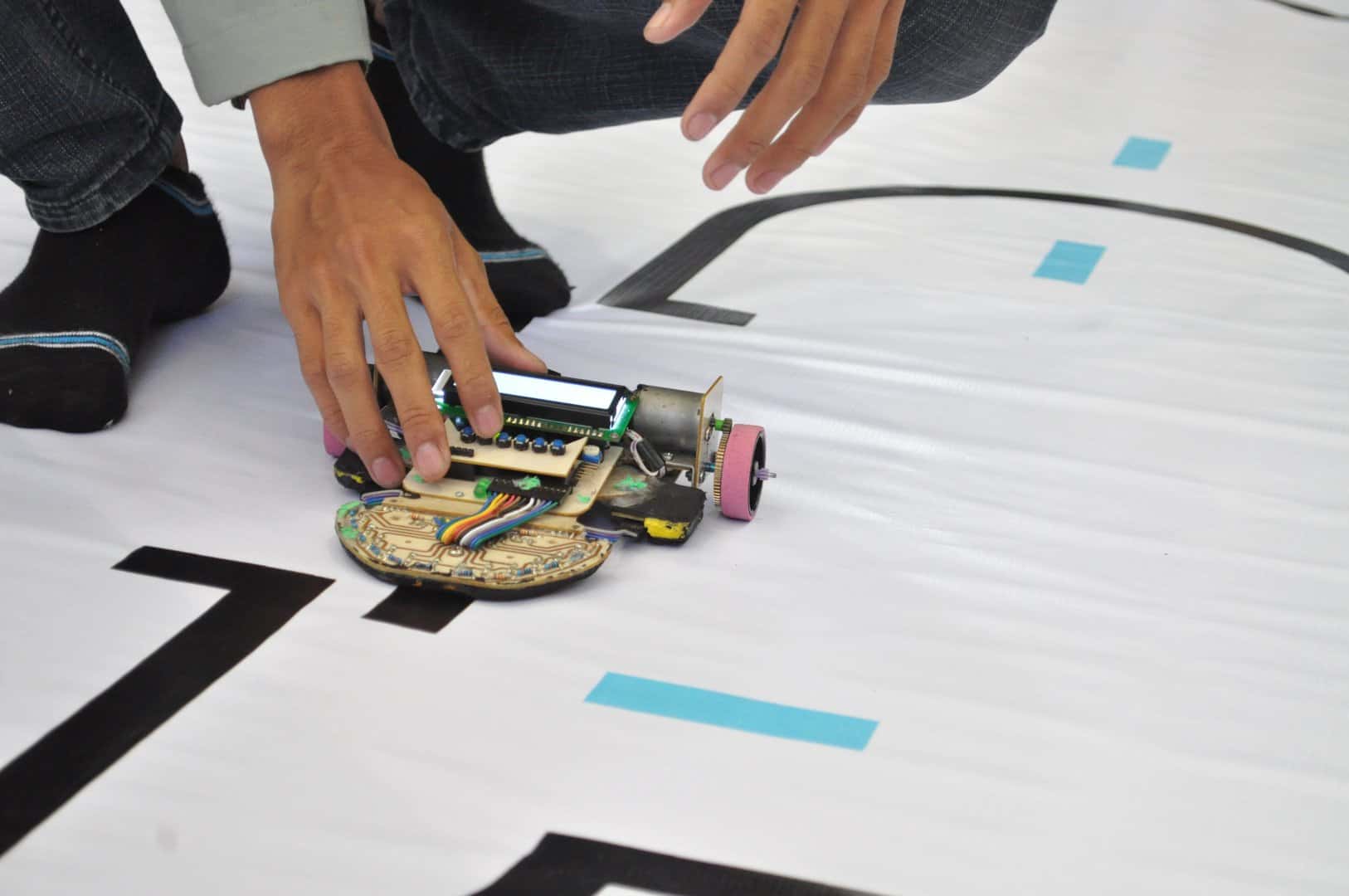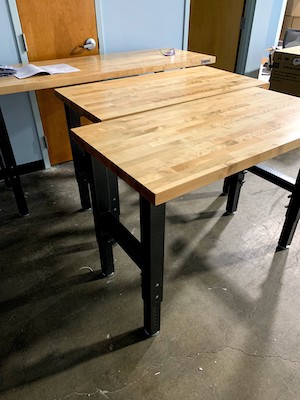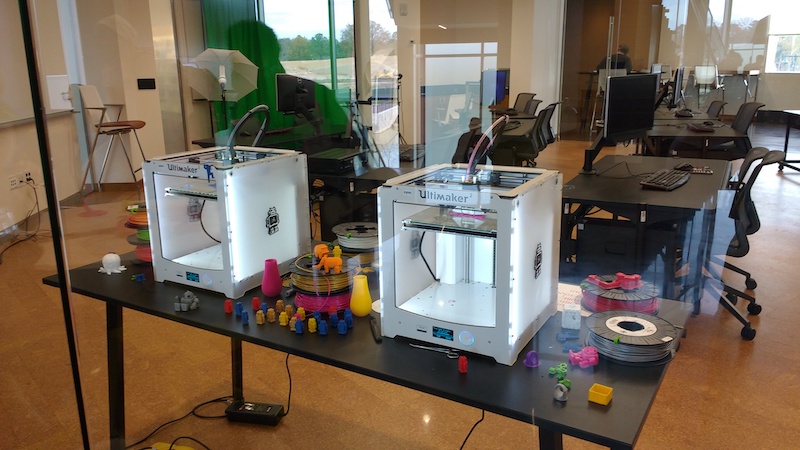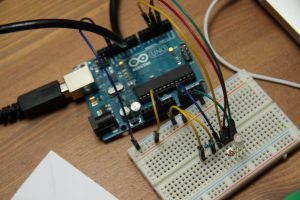Clubs are a great way to unite people that are interested in the same topics. Robotics clubs are no exception! If you’ve been tasked to start a robotics club, then you’ve come to the right place. Robotics is a complex subject, so don’t expect to have your program set up overnight.
With some careful planning and organization, you can launch a robotics club or start a robotics team within a couple of weeks.
Need help starting a robotics class? We can help. Check out our Enterprise Consulting services.
In this article, I’ll share with you the steps to starting a robotics club. Consider this the comprehensive, tactical guide that anyone can use (regardless of whether you have robotics experience or not) to get their robotics club started.
There’s quite a bit of information here, so I recommend bookmarking this page for future reference. Now, let’s talk about the steps needed to start a robotics club.

Step 1. Decide on the Robotics Club Purpose
Before you can start a robotics club, it’s important to decide on its purpose. It’s important to survey students, teachers, administrators, and parents.
Figure out what members will want to work on. Decide if you have enough interest to have a functioning club.
Then, determine if the robotics club will be educational, competitive, informative, or a combination.
Educational: Build and Learn with Robots
One of the easiest ways to convince an administration, PTA, or organization to approve a new robotics club is to have an educational purpose. Because robotics is a combination of programming, electronics, and mechanics, the robotics club provides a valuable learning environment to promote skills that translate well into STEM careers.
Did you know you can get government funding for robotics programs? There are quite literally millions of dollars in federal funding for STEM programs.
Go after it and get the resources to set up a good program. Anyone can slap together a few $50 robot kits — but if you have better resources, you can create a program that will last and provide better learning outcomes.
Plus, students have a lot of fun building robots and it’s a skill that pays off with $100,000+ careers, which is a win-win all around.
Competitive: Solve Challenges and Compete
Another reason to start a robotics club is to compete in robotics competitions. There are a lot of national and local robotics leagues including FIRST and VEX. While these are very popular, there are costs associated with starting up a robotics team, building the robot, and traveling to events.
Expect to spend $5,000 to $50,000 per year depending on which league you choose and what type of robot you have to make plus travel, parts, tools, and equipment.
Many teams are self-funded, get government grants, or find sponsors. The more funding you can get for your program, the less you have to worry about doing things on the cheap and cutting corners.
Informative: Share and Collaborate
The third reason to start a robotics club is to provide a forum for sharing new technologies, individual robotics projects, and any upcoming events within the community.
Think of a “robotics meetup group.” If you’re starting a robotics club that’s open to the public, then this could be a good purpose to adopt.
A lot of community robotics clubs meet monthly and provide a place for networking, collaborating, and sharing tips and tricks. It’s less about providing formal education side, and more about bringing like-minded individuals together to talk about robots.
Step 2. Actually, Start a Robotics Club
The next step is to sit down and plan out the robotics club. Some questions to think about are:
- What is your budget?
- Who will run club meetings?
- What ages will participate?
- When and where will the robotics club meet?
It’s important to take time and propose answers to these questions before taking your club idea to your organization or administration.

They’ll probably ask you these questions, and if you don’t have a good answer, it’ll take longer to get your robotics club approved. Now, let’s talk about each of these questions in more detail.
What’s the Budget?
One critical factor in starting any club is the budget.
Similar to how a sports team needs uniforms and equipment, robotics requires robotics kits, tools, computers, and knowledgeable staff.
These all add up, especially if you’re going to have 10+ members involved in your club.
At a bare minimum, I recommend having around $50,000 to launch a robotics club or program — especially if this is a new school or education program or even a local robotics company.
Anything cheaper than this, and the program won’t survive. It costs a lot more money than people realize to get into robotics.
Computers, kits, tools, space, trainers, and curriculum cost money. Without money, the program doesn’t have a chance to survive.
How do I know?
We’ve worked with hundreds of organizations and helped thousands of students over the years, and usually the cheaper the program, the crappier the outcomes and the sooner the program dies.
Finding knowledgeable staff, having great equipment, and executing a program for a few thousand dollars just won’t cut it. Staff want to get paid. Equipment costs money. You get the picture.
What you put into your program is what you’ll get out of it. You can’t expect to have a good robotics program that is cheap.
The more funding you can set aside (or charge members), the better your program will be.
How to Divide the Budget
I recommend setting aside around 10-25% for tools, 50-75% for kits and hardware, and 25-40% for training and curriculum. These are just ballparks, but with planning, you can figure out what works well for your class.
And if you plan on having equipment like CNC machines, Laser Cutters, and 3D Printers, you’ll want to add more to your budget to get safe, quality equipment. Do not go cheap on this, especially if you’re offering these machines to the public or students. You do not want to have to worry about safety or injuries.
If you’d prefer to have your robotics class set up for you, we offer Education and Enterprise Consulting Solutions. Contact us here.
Additionally, if you don’t have computers, you’ll need them. Not tablets, but laptops or desktop computers.
Here are some great options if you’re looking at computers.
If you have a choice between Chromebook or not, I’d choose not.
Windows or Mac options are more expensive, but they provide greater flexibility. Sometimes you don’t have a choice, and that’s okay. If you do though, consider picking up a standard OS like macOS or Windows 10.
Now that you have an accurate representation of the club’s budget, it’s time to decide who will run the club.
Who will lead the robotics club meetings?
If it’s you, then you can skip this step. Otherwise, you’ll need to appoint a teacher, parent, volunteer, or mentor to run the robotics club.
Some community robotics clubs (where the members are 18+) are self-sufficient and the members run the meetings.
If you’re setting up the robotics club as part of a school, then you’ll want to make sure you have enough adults for the age and number of students involved.
Check with the administration to make sure you meet the requirements for your school.
Is starting a robotics club or program too complicated for you? We can help. Learn more.
Which age group(s) will participate?
You have a purpose, a budget, and a leader for your robotics club. But, who will be participating?
- Is it an adult robotics club?
- A robotics club for elementary kids?
- A middle or high school robotics club?
It’s important to define the age group for your robotics club. Typically, if you’re starting an afterschool robotics club, the club is geared towards the same age group as the school.
It’s important to define the age group so that you can purchase appropriate robots and tools.
It wouldn’t make sense to buy a bunch of Raspberry Pi’s, sensor kits, and power tools if you’re running an elementary robotics club. The same is true for other age groups.
Use the age group to provide appropriately aged kits, components, and learning materials to make your robotics club a success.
Where and when will the robotics club meet?
Lastly, decide on where and when the robotics club will meet. Is it a monthly, weekly, or daily club? What time is it held? After school? Before school? On the weekends?
Set a schedule for your robotics club and make it public to your members. This is especially important for new robotics clubs because no one likes to feel “out of place.” By securing a meeting spot and time, you’ll put newcomers at ease.
Step 3. Pick out Robotics Kits and Tools
You can’t have a robotics club without robotics kits and basic tools. The rest of this article is dedicated to an updated list of equipment, parts, and tools that you’ll need to start your robotics club.
Let’s get started!
1. Robotics Kits & Components
The most important part of starting a robotics club is having robotics parts, kits, and components at your disposal. I always recommend having at least one robot per member. Otherwise, members without a kit will be bored.
We don’t share computers anymore, so the same philosophy applies to robots.
If you’re hosting an afterschool or extracurricular robotics club, it’s nice to have a variety of spare parts so that everyone can be involved. The specific kit you buy has to make sense for the age group of the robotics club.
Here are some robotics kit ideas divided up by age groups:
- Ages 5-10:
- Ages 11-14:
- Ages 15-18+:
👉 And here’s an article on the best robotics kits for the 2020s.
Other than Amazon, you can buy robotics parts, fasteners, and components on Robotshop.com, McMaster-Carr, Arrow Electronics, Adafruit, and SparkFun.
Or, have your full robotics program done for you: Robotics curriculum, Kits, and Professional Development all-in-one with Learn Robotics.
2. Laptops/Computers
The next thing you’ll need is a computer lab or laptop cart.
I recommend getting computers that have at least the following specifications:
- Processor: Intel i7 or better
- RAM: 16 GB
- SSD: 512 GB SSD
- Operating System: Windows 10 or 11, macOS, Ubuntu
- Communications: Bluetooth & WiFi
Heading into 2024, I’d highly recommend the MacBook Pro or the Razer Blade 15 (Windows/Linux).
I’ve been a big fan of the MacBook since 2012 when I bought mine. A lot of people presume that Macs are “too expensive;” however, I’ve had my 2012 Mac for almost 8 years now, and it’s a beast.
👉 You can check out my full recommendations for robotics laptops here.
3. Desks/Chairs/Workbenches
Thirdly, you want to make sure the room you’re using has enough desks, chairs, and workbenches for members to work at. Most classrooms already have tables and chairs.

You can move a bunch of smaller desks together to create collaborative workspaces.
If you’re tasked with furnishing the space as well, I recommend the following furniture and fixtures for your robotics club:
- Craftsman Tool Chest
- Workbench with Outlets
- Rolling Workbench with Drawers
- Rolling Whiteboard
- Locking storage cabinet
- Workbench Stools
- Cabinet Storage Set
- Pegboard Organizer
Bookshelves, toolboxes, and clear storage bins are also helpful to organize the club.
Tools often walk away, so if you have a home for them, you’ll be able to keep track of everything.
4. Hand Tools & Power Tools
Additionally, you’ll want to have basic tools such as screwdrivers, wrenches, pliers, and scissors available. There are some great household toolsets that you can buy to get an assortment of the basics.
Some brands I recommend are DEWALT, Stanley, Cresent, Craftsman, Ryobi, and KOBALT.
If you have to buy tools, don’t cheap out.
Good tools last a while. Cheap ones break often. Simple as that. The only time I’d recommend cheap tools is if you’re afraid people will “walk” with them.
Here are a few tool sets I recommend for your robotics club:
- Craftsman Tool Set
- Topline Tool Set
- Allen Key Set
- Fluke Multimeter
- Digital Calipers
- Wire Strippers
- Wire Snips
- Leatherman
- Mini Screwdrivers
- DEWALT Drill Set
- Tape Measure
While I don’t recommend having industrial-grade power tools, a couple of drills and hot glue guns make assembling robots a lot faster.
You can also pick up a label maker to mark all the tools that belong to the club.
This is a great way to ensure you have all the tools and to deter tools from disappearing.
5. 3D Printers & Laser Cutters
Lastly, I wanted to mention some cool items that you may want to consider for your robotics club.

3D printers and Laser Cutters can be used to manufacture custom parts. If you’re offering the robotics club to the community, this is a great way to get people into your club.
Here are five 3D printers worth adding to your Robotics Club:
I generally look for printers that are already assembled, fully enclosed, and have a large build area. This provides a safer and easier experience for your users.
- Flashforge Adventurer 4 Pro
- Flashforge Adventurer 5M
- Creality K1 Max
- QIDI Technology Max3
- Dremel DigiLab 3D45-01
If you’re going to get a laser cutter that will be used by the general public, I recommend Glowforge Pro or Glowforge Aura.
Most people don’t have regular access to laser cutters and 3D printers, so it’s a nice feature to have. If you have an interest in CAD modeling, robotics, making, and more, then a 3D printer is a great way to get started!
If you’re hosting the robotics club at a school, this could be a great way to introduce 3D printing and laser cutting to students.
Get Ahead with your Robotics Club
In this article, we explored ways to start a robotics club. This tactical guide can help you launch a brand new robotics club, start a robotics team, or integrate robotics into existing extracurriculars.
Robotics is a complex subject and does require planning. But with a little preparation, you can bring the fun of robotics to your school or community.
If you’re looking for an all-in-one solution to structure, innovate, and advance your robotics class, then you’ve come to the right place.
You can get certified in robotics as an individual, or hire us to set up your robotics program.
Every student gets a kit, which they can use to follow along with the online activities. While they’re building, they’re learning.
This is an effective way to teach students the fundamentals of coding, electronics, and robotics.





4 Responses
Robotic Club Teacher Sponsor at Middle School.
How do we find local robotics competitions for middle school students with very low budgets to start with?
Hi Larry, we have some awesome options for starting local robotics competitions through our Club Sets. Feel free to check them out or schedule a call with our team and we’d be happy to help you out! ~Liz from Learn Robotics
Grandparent 81 , very retired ! Some programming years ago (1970s) w Apple IIs and college computer lab management
1. How to get middle school/elementary girls and minorities enrolled/members of a robotics club ?
2. Start up grants for schools (elementary/middle school) ?
Live in Estes Park, CO, grandkids in Steamboat Springs, CO
Thanks,
Greg
Hi Gregory!
Exciting world of technology! Here are some quick answers to your questions:
1) Create the robotics club (we have a really great robotics program that you could offer that provides the materials you need to get started!) and then market it to those students. Schoolboards, PTO, and other community groups can help with this!
2) This is a great question – we’re working on creating a list of grants that will be released on the Learn Robotics website really soon – stay tuned!
Best,
~Liz from Learn Robotics